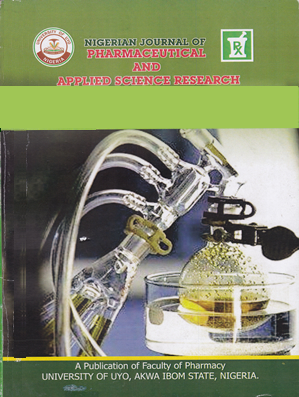Evaluation of the phytochemical constituents and antioxidant activity of the stem of Senecio biafrae (Asteraceae)
Contenu principal de l'article
Résumé
The use of herbal products is of global importance because of their low side effects, accessibility and affordability when compared with conventional medicine. The objective of this study was to investigate the phytochemical content and in-vitro antioxidants activities of the methanol extract of Senecio biafrae stem. The methanol extract was obtained by cold maceration method. Phytochemical investigation was carried out using standard procedures. In-vitro anti-oxidant activity was estimated by 2, 2-diphenyl-1-picryl hydrazyl (DPPH) radical scavenging activity and Ferric Reducing Antioxidant Power (FRAP) assay. The qualitative analysis revealed the presence of alkaloids, reducing sugars, cardiac glycosides, steroids, flavonoids and saponins while tannins and anthraquinones were absent in the extracts. The DPPH assay showed percentage inhibition ranging from 40.08±0.26 to 47.27±0.02% for Seneco biafrae stem extract, 96.64±0.07 to 98.76±0.01% for ascorbic acid and 54.62±0.06 to 58.99±0.06% for alpha tocopherol, with IC50 112.58 ?g/ml, 5.66 ?g/ml and 18.51 ?g/ml respectively. The FRAP assay of the extract was 107 ?M Fe2+/g dry extract while the positive control (ascorbic acid) had a value of 272.5 ?MFe2+/g dry material. This study shows that the methanol extract of Senecio biafrae stem possesses various phytochemical constituents, has antioxidant potential and could be very useful in the prevention and treatment of various diseases and ailments.
Téléchargements
Renseignements sur l'article

Cette œuvre est sous licence Creative Commons Attribution - Pas d'Utilisation Commerciale - Pas de Modification 4.0 International.
Références
Adebooye OC. (2001). Wild plants for medicinal and culinary use. Nigeria in sharing innovative experience on sustainable use of indigenous food and medicinal plants. Third world academy of Scienc and UNDP, Trieste, Italy, pp, 69-78.
Adebooye OC. (2004). Senecio Biafrae (Oliv. and Hiern). In: Jeffrey, C. and G.J.H. Grubben (Ed.), Denton OA. PROTA, Wageningen, Netherlands. Macmillian Publishers.
Ajiboye BO and Ojo OA. (2014). Effect of aqueous leaf extract of Senecio biafrae on hyperglycaemicand haematologicalparameters of a. lloxan-induced diabetic rats. Pharmacologyonline. 164(3): 163-169.
Ajiboye BO, Ibukun EO, Edobora G, Ojo AO and Onikanni SA. (2013a). Chemical composition of Senecio biafrae leaf. Scientific Journal of Biological Sciences. 2(8) 152-159.
Ajiboye BO, Ibukun EO, Edobor G, Ojo AO and Onikanni SA. (2013b). Qualitative and quantitative analysis of phytochemicals in Senecio biafrae leaf. International Journal of Inventions in Pharmaceutical Sciences. 1(5): 428-432.
Amin I, Zamaliah MM, and Chin WF. (2004). Total Antioxidant activity and phenolic content of selected vegetables. Food Chemistry. 87: 581-586.
Aruoma OI. (2003). Methodological considerations for characterizing potential antioxidant actions of bioactive components in food plants. Mutation Research. 9(2): 523 – 524.
Ayoola PB and Adeyeye EI. (2010). Phytochemical and Nutrient Evaluation of Carica papaya (pawpaw) leaves. International Journal of Research and Revive and Applied science. 5(3): 325-328.
Azeez L, Ogundode SM, Ganiyu OT, Oyedeji OA, Tijani KO and Adewuyi S O. (2015). Spectra characterization, flavonoid profile, antioxidant activity and antifungal property of Senecio bifrae and its copper complex. Scientific research and essays.10(18): 593-599
Benzie IFF and Strain JJ (1996). The ferric reducing ability of plasma (FRAP) as a measure of antioxidant activity: the FRAP assay. Analytical Biocemistry. 239 (10): 70-76.
Dairo FAS, and Adanlawo IG. (2007). Nutritional quality of Crassocephalum crepidioides and Senecio biafrae. Pakistan Journal of Nutrition.6(1): 35-9.
Dragland S, Senoo H and Wake K. (2003). Several culinary and medicinal herbs are important sources of dietary antioxidants. Nutrition. 133(5): 1286-1290.
Fowomola MA and Akindahunsi AA. (2005). Protein quality indices of sand box (Hura crepitans) seed. Journal of Agriculture and Environtal science. 3: 16-19.
Hamzah RU, Jigam AA, Makun HAand Egwin EC. (2013). Antioxidant Properties of Selected African Vegetables, Fruits and Mushrooms: A Review. INTECH, 9, 203- 250.
Hirano R. Sasamoto W. Matsumoto A. Itakura H. Igarashi O and Kondo K. (2001). Antioxidant ability of various flavonoids against DPPH radicals and LDL oxidation. Journal of Nutritional Science and Vitaminology. 47 (5): 357-362.
Knekt P, Kumpulainen J, Järvinen R, Rissanen H, Heliövaara M, Raunanen A, Hakulinen T, and AromaA (2002). Flavonoid intake and risk of chronic diseases. America Journal of Clinical Nutrition. 75, 560-568.
Landry LL, Bruno PT, Charlotte N, Bale B, Goka SC, Yemele DM, Tagne RS, Donfack NJ, Mbemya GT, and Rodrigues APR. (2015). Comparative effects of the crude methanol/methylene chloride extract and fractions of Senecio biafrae (Oliv. & Hiern) J. Moore on some fertility parameters in immature female Wistar rats. Asian Pacific Journal of Tropical Disease; 5(5): 404-411.
Odukoya OA, Thomas AE, and Adepoju-Bello A. (2001). Tannic acid equivalent and cytotoxic activity of selected medicinal plants. West Africa Journal of Pharmacology. 15, 43-45.
Okoro IO, Umar IA, Atawodi SE and AnigoKM. (2014). Comparative Antihyperglycemic Effect of Petroleum Ether, Acetone, Ethanol and Aqueous Extracts of Cleome rutidosperma DC and Senecio biafrae (Oliv. and Hiern) in Streptozotocin-induced Diabetic Mice. British Journal of Pharmacology and Toxicology. 5(3): 115-124,
Okwu DE and Okwu ME. (2004). Chemical Composition of Spondias mombin linn. Plant parts. Journal of sustainable Agriculture andthebEnvironment. 6(2); 140-147.
Okwu DE. (2005). Phytochemicals, vitamins and mineral contents of two Nigeria medicinal plants. International Journal of Molecular Medicine and Advance.science.1(4);375-381.
Persinos GJ and Quimby MW (1967). Nigerian Plants III. Phytochemical screening for alkaloids, saponins, tannins. Jourmal of Pharmaceutical. Science. 56 (2) 1512.
Prohp TP and Onoagbe IO. (2012). Determination of phytochemical composition of the stem bark of triplochiton scleroxylon k. schum. (sterculiaceae). International Journal of Applied Biology and Pharmaceutical Technology. 3(2): 68-76.
Stray F (1998). The natural guide to medicinal herbs and plants. Tiger books international, London, pp. 12 -16.
Telefo PB, Lienou LL, Yemele MD, Lemfack MC, Mouokeu C, Goka CS (2011). Ethnopharmacological survey of plants used for the treatment of female infertility in Baham, Cameroon. Journal of Ethnopharmacology.136(1): 178-87.
Trease GE and Evans WC. (2002). Phytochemicals. In: Pharmacognosy. 15th ed. Saunders Publishers, London. 42-44, 221- 229, 246- 249, 304-306,331-332, 391-393.
Trease GE and Evans WC. (2005). Pharmacognosy, 11th edition. Brailliar Tinidel Can. Macmillian Publisher


